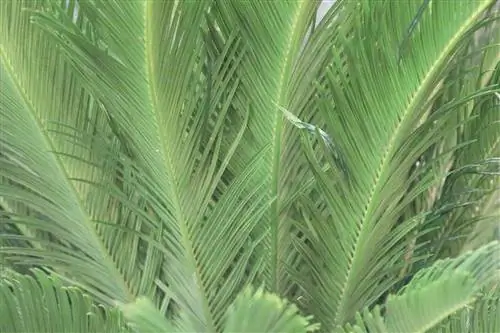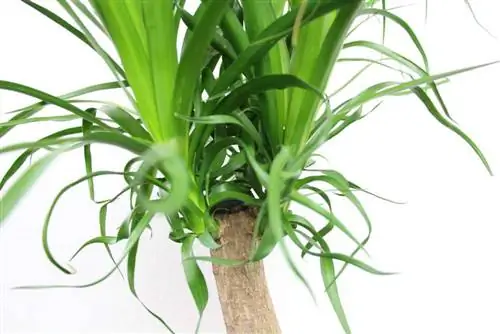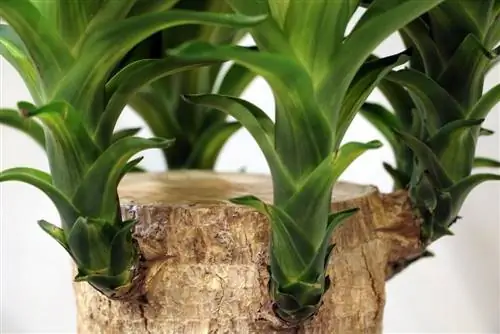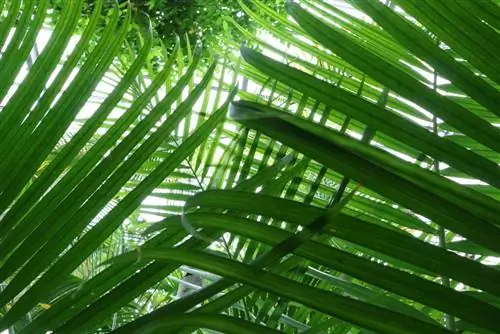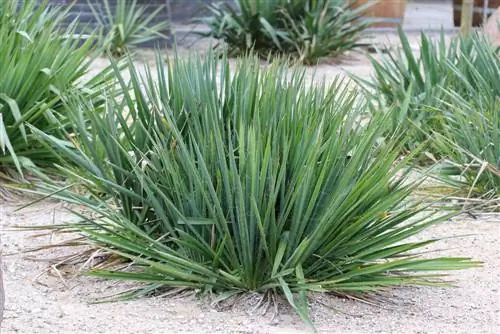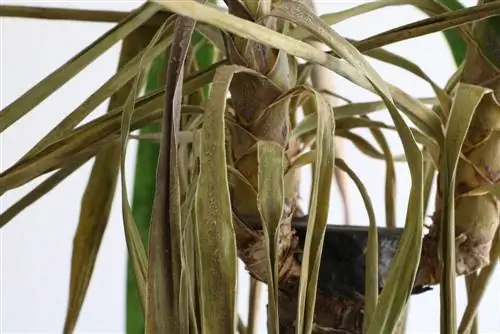- Author admin [email protected].
- Public 2023-12-17 03:39.
- Last modified 2025-06-01 06:48.
The Cycas revoluta, incorrectly called the sago palm, is the dinosaur among plants. As one of the oldest plants in the world, cycads are not palm trees because they have not reached this stage of evolution.
If you bring home the easy-care and slow-growing but beautiful and decorative fossil with its dark, long and elegant fronds, you can admire it for many years in the plant pot in the house and even planted out in the garden.
Caring for Cycads
The Cycas revoluta, actually a further development of the ferns and hence its name cycad, is native to Southeast Asia. Due to its robustness and ease of care, it can also grow to a considerable size in local latitudes. The firm and funnel-shaped fronds of the cycad are covered with pointed, dark green, shiny needles. Finely and evenly feathered, the cycads love to sway their elegant fronds, usually up to 100 cm - which can reach a length of up to 2 meters under optimal conditions - in the light summer breeze.
Poting and planting the sago palm
The roots of cycads grow downwards. A deep pot that is a few centimeters wider than the trunk is sufficient for the sago palm to feel comfortable. The root of the cycad drills into the ground like a dagger and ensures a secure hold of the heavy and massive trunk. Thanks to the roots that grow deep into the ground, the palm tree can find a lot of nutrients in its native Southeast Asia, even in the smallest of spaces. Even when fires destroy everything in tropical forests, cycads are among the survivors, with new shoots forming from their strong, deep-seated roots even years later. However, the undemanding cycad requires some special care measures. Even if only rarely, the sago palm should only be watered with particularly soft water. Rainwater or well-stagnant water is ideal.
Situation conditions for the cycad
The ideal location for the cycad is bright with medium UV radiation. If it is protected from too much rain or snow water, nothing stands in the way of decades of enjoyment of the decorative plant. However, it should only be introduced slowly to intense UV radiation, which can burn its leaves. Indoors or outdoors, the sago palm needs a bright place - even in winter.
Cutting off fronds
Brown or yellow fronds can be cut off, but they will not grow back in the same place. The sago palm sprouts from its upper middle, from which a whole round of new leaves unfolds, long and pointed.
Nitrogenous fertilizer
A fertilizer containing nitrogen is good for the sago palm. Ornamental plant fertilizer is not recommended and, if in doubt, a cactus fertilizer is preferable. Lawn fertilizer with a high nitrogen content (“N”) is particularly suitable - if no special cycad fertilizer is available. The substrate of the sago palm should always have a pH value of less than 7. Special test kits for soil pH are available from specialist retailers.
Overwintering the cycads
The cycads have good frost tolerance, which means they can spend the mild winter outdoors. With increasing cold and decreasing light, the cycad stops its main growth as early as October. Even if the cycad spends the winter in the slightly heated but light interior, it is generally neither watered nor fertilized during the rest period from October to March. If the pot dries out completely, a few shot glasses of water can be added. However, under no circumstances should fertilization be carried out in winter. The fronds can only be sprayed with water if there is a lot of heat due to dry heating air.
Tip:
The cycad must be prepared for its stay in the winter landscape. Covering with bark mulch or winter film protects the pot from frost damage. The plant pot is placed on a frost-free surface (Styrofoam or wooden blocks) so that neither waterlogging nor extreme cold zones form. It is important to protect the cycad from the large amounts of water in the autumn and winter. A covered location is advantageous, although the fronds should also be protected from icy drafts. If the cycad is outdoors and is completely soaked, it is recommended to protect it from further moisture (change location).
Packing the cycad in bubble wrap or special plant film should definitely be done before soaking to avoid damage and rot. To do this, the fronds are tied up with the foil, which is well protected from moisture. The trunk can also be packed in a cold-proof manner. When mulching the sago palm, fertilizer must be applied immediately at the start of the growth period so that the nitrate removed by the mulch is replaced in the substrate.
- bright and wind-protected location
- up to minus 7 degrees outdoors
- Ideal in the living room at 5 to 10 degrees Celsius.
Diseases, pests and care errors
Overwatering and overfertilization are among the most common diseases of sago palms. The cycad can also be attacked by mealybugs and scale insects.
Bad lighting conditions (too dark, exposed to strong sunlight too quickly), a pot that is too low and usually it is over-watering and over-fertilization that makes life difficult for the sago palm. But even if the plant seems hopeless, if all the fronds have fallen off or turned yellow, there is no reason to abandon the robust, ancient fern species. First, repot into unfertilized soil and stop watering and fertilizing. The sago palm is almost guaranteed to recover if attention is paid to sufficient lighting conditions, minimal watering and sparing fertilization with a fertilizer rich in nitrates and low in phosphorus - although this can easily take several months.
- sparse fronds, with twisted leaves in low light conditions
- watering with stem rot
- yellow fronds due to too much moisture or incorrect fertilization
- brown needles in unfavorable lighting conditions or excessive dryness (the latter rare)
What you should know about the sago palm (cycad) soon
The cycad is a highly decorative and easy-care cycad. The massive and voluminous nutrient-storing trunk of the sago palm doesn't mind long watering breaks and only needs to be fertilized rarely. The slow-growing sago palm is in a deep pot and can thrive both indoors and outdoors.
The cycad, which comes from Southeast Asia, is an impressive plant. Around its thick, cylindrical trunk grow 50-200cm long fronds that are finely structured and have a strong, dark green color. The plant grows very slowly, which is probably why they are sold relatively expensive.
- The ideal location is very bright, but without direct sun. In summer, the Cycas revoluta can also be placed on the terrace, if possible in some shade and protected from the wind.
- The plant is by no means winter hardy, so it needs to be brought back into the house before the cold autumn nights. In winter the plant should be kept cool, at least 12 degrees Celsius, in summer temperatures around 20-22 degrees Celsius are ideal.
- Of course, the sago palm can overwinter at room temperature if it is kept in the room all year round.
- The water requirement is in the medium range. The root ball should never dry out completely, but waterlogging should also be avoided. Water moderately but regularly.
- With daily spraying, optimal humidity of around 60-70% is achieved. This is particularly necessary at times when new growth begins.
- You should be careful with fertilizer, the plant reacts sensitively to the wrong fertilizers or to over-fertilization.
- Cow dung is ideal and can be used to fertilize the plant occasionally in spring and summer. Commercial flower fertilizer should only be used at 0.05% and only if there is no other option.
- The sago palm is repotted before new shoots appear in spring. Sandy-loamy, but permeable and humus-rich soil is used.
- Propagation takes place by seeds, although there can hardly be any guarantee of success. A very high soil temperature is required for germination, around 25-30 degrees Celsius.
- Pests are not expected. Spider mite infestation can only be observed when the air is too dry.

